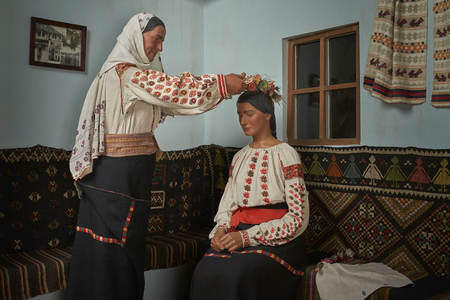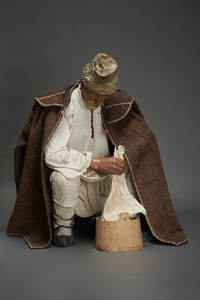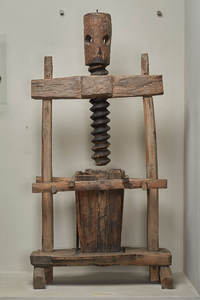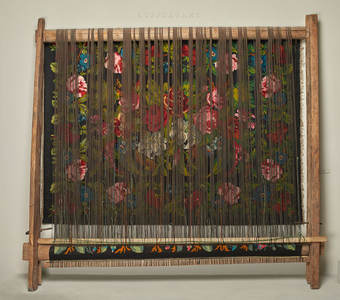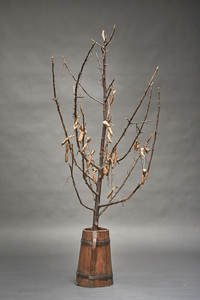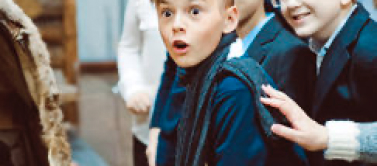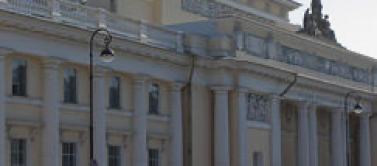Moldovans. Late 19th – early 20th century

The traditional Moldovan culture developed under the influence of nations of the ancient world and northern Black Sea coast, the Balkan Peninsula, and Eastern Europe, which communicated in the country’s territory for many centuries. At the Museum exposition, you may see its colorful features. Why was Moldavia famous for its grapes and wine? What species of sheep did the Moldovans raise? Why is white cheese the main food of the ethnic cuisine? What was hominy cooked from? What gave the ethnic costume its inimitable flair? What does the Moldovan carpets’ originality consist in? What did the casa mare room look like? What was its role in a residential house? What did the staff of the wedding attendant look like? Why did they bake many kalach buns for holidays? Why did Moldovan lads stroll with a plow on a New Year night? What masks did guisers put on? What theatrical shows did rural people perform?
The display “Moldovans. 19th and 20th centuries” introduces the visitor to the traditional culture of the people that lived in Russia’s south-west in the late 19th / 20th century, where the warm climate, very fertile soils, and a peculiar terrain promoted not only development of arable farming and cattle raising, but also successful vine growing and wine making.
As you move inside the room, you see the most specific elements of the traditional Moldovan culture closely related to their centuries-long history.
The introductory part of the exposition arranged to the left of the room entrance is opened with the map of Bessarabia Province (the name stems from the Basarab dynasty, 14th century). Along with the Moldovans, many peoples lived in its territory – Russians, Bulgarians, Germans, Gagauzi, Ukrainians, Poles, Gypsies etc. This complex ethnic structure of population could not but influence the culture of the Moldovan people, which still remained unique and original. Moldavia’s established religion was Christianity. Nevertheless, some rites and customs of the Moldovans retained folkways related to pre-Christian beliefs. The Moldovan language was formed on the basis of Romanic languages of the Indo-European language family.
Agriculture
The part of the room to the right of the entrance is dedicated to the Moldovans’ agriculture, where arable farming, vine growing, and cattle farming were the main sectors. The main occupation of the Moldovans in the late 19th and early 20th century was arable farming favored by the warm climate and fertile land, where various grain (wheat, barley, oats, corn) and industrial crops (tobacco, sugar beet, sunflower) were grown. The black-earth Moldovan soils enabled the use of the fallow and slash-and-burn system; later, two-course and three-course fallow system became widespread. By the late 19th century, about 80 percent of Moldavia’s population was employed in agriculture.
Vine growing and wine making
Vine growing was one of the oldest and most important sectors of Moldavia’s agriculture. It was especially successful in the central region of Kodry and in the south of Bessarabia were the natural conditions were the most favorable for it. The largest points of sale of Bessarabian wine and grapes were Kishinev, Akkerman, and Odessa, from which the products were carried to Ukraine, to Moscow and Petersburg, and abroad.
Grapes were processed into wine manually, with the aid of special handicraft tools, which required great labor input. The main jobs were grape mashing and crushing, fermentation, removal of free-run juice, and pressing. Among the tools presented in the display, of special note is the wooden grape press dated early 20th century.
Cattle farming
Another traditional occupation in Moldavia was cattle farming, which lost its dominant position at the end of the 19th century, as arable farming developed.
Local people raised bovine cattle, sheep, horses, pigs. Sheep farming was the most developed sector of stock raising. Sheep wool was a major commodity at fairs, and a product for export. Sheep farming also provided milk and meat. In large farms, herds numbered up to two thousand sheep.
Shepherds played an important role in the Moldovans’ traditional culture, because it was they who handled herds of sheep. The head shepherd, or scutar, spent nearly all the time near the sheepfold, while the other shepherds pastured and milked sheep. Milk processing and preparing sheep cheese was the job for the oldest and most experienced shepherd, or bach. In the exposition, you can see the scene of white cheese making where a shepherd is the main character.
Settlements, estates, and dwelling places
Left of the Agriculture sector is a topical unit dedicated to traditional Moldovan dwelling places. Presented here are photographs of Moldovan settlements, a map of the main dwelling types in the northern central, and southern regions, and the internal layout plan of a Moldovan house.
The settlements of the Moldovans, depending on historical, economic, and geographical conditions, had various layouts – compact, scattered, river-based, and street/block based. Moldovan settlement consisted of estates comprising a dwelling house and outbuildings, i.e. barn, shack, cellar, and summer kitchen, which formed a single-row compound or were scattered about the yard.
Most peasant houses had wattle walls clay-coated on both sides. On the banks of the Dniester and Reut rivers, limestone was used as construction material, in the central region Kodry it was wood, and on the right bank of the Dniester it was saman, unfired bricks. Four-pitch or two-pitch roofs were covered with cane or lath.
Presented in the display are such features of a Moldovan house’s appearance as a fragment of a cane-covered roof, earth skirt prispa, and small carved wooden or stone pillars. A typical Moldovan house had a three-part structure: the entrance in the center connected the living room kemara to the show room casa-mare via the entrance hall tinde.
The central part of the exposition is a fragment of the exterior of a Moldovan dwelling place with small columns and caned roof, and casa-mare, the show room where a most important moment of the Moldovan wedding rituals is presented – the scene of the bride’s dressing by the proxy mother. The overall similarity of their costume is noticeable, the important markers being the bride’s headgear venok and embroidered serviettes nafranicas attached to the proxy mother’s clothes. The casa-mare was always tidied up as if prepared for a grand feast. The most memorable family events were celebrated here. Sometimes it was also used as a working space for weaving carpets.
The casa-mare contained all the most valuable things in the house: the walls and floor were covered with homemade carpets and runners, in the God’s corner was an icon and traditional Moldovan towels, and earthenware filled with treats (dried fruit, candy, and pastries) stood under the benches. The dowry lovingly prepared by the mother for her daughter was piled up on a richly decorated chest.
Weaving and carpet making
Another sector of the display is dedicated to Moldovan weaving, presenting the stages of hemp processing, woven sashes and towels, and photos of Moldovan weavers at work.
In the late 19th and early 20th century weaving was quite a widespread home occupation in Moldavia; it had an old tradition. The materials were hemp and wool, and sometimes flax. Yarn preparation and weaving were done with home-made wooden tools. Among the displayed exhibits is a kind of a distaff with an elongated shaft enabling spinning on the move.
The Moldovan women weaved and embroidered a lot of towels, which were made on a horizontal loom, or stativ. The ornaments were rhythmic repetitions of a geometric or floral pattern. The exhibited towels are multifunctional, serving as marame headdresses and as towels for domestic needs and for decoration of living interiors.
A traditional component of the men’s and women’s costume was a woolen belt – sole-colored (red, green, white) or multicolor with patterns. Such belts were woven on a horizontal loom using a huckaback or Jacquard technique, or on planks.
The age-old traditions of Moldovan carpet making helped to form an original type of carpet, which was made on the vertical loom război in the kilim technique. One of such looms is presented at the exposition. It is displayed at an initial stage of carpet making, visibly demonstrating the process.
For dying the threads, Moldovan craftswomen of the late 18th and 1st half of the 19th century used natural dyes, and from the second half of the 19th century the pastel ground of carpets was replaced by black, brown, green, and red with the aid of aniline dyes. The carpet pattern was based on geometric and floral motives; zoomorphic and anthropomorphic images were less frequent.
Clothes
The exposition displays several variants of the traditional Moldovan costume. Among them are men’s and women’s festive garments of Moldavia’s northern regions and a bride’s costume from Transnistria.
The general attributes being similar, the clothes of Moldovans of different regions had noticeable distinctions. The women’s costume in the north of Moldavia consisted of a chemise richly decorated with embroidery, woolen skirt (catrinţa), patterned sash, and towel-like headgear. Women in the central part of Moldavia wore a chemise, a gathered woolen skirt, a woven sash, and a kerchief. In the costume of Moldovan women of the left bank of the Dniester, bright embroidered chemises combined with dark pinafores. In the south, women’s clothes had coloristic modesty: a chemise just slightly decorated with embroidery made an ensemble with a gathered woolen skirt or with a pinafore, apron, and kerchief.
A light color gamut was typical for men’s wear of the northern and central regions, where they wore white shirts and trousers, a woven belt, a straw hat or a fur cap. In the south of Moldavia, the men’s wear consisted in a white shirt tucked in dark-colored cloth trousers, a wide woolen belt, and a cap.
A prerequisite of the men’s and women’s costume was a fur waistcoat (bondice, pieptar) of tanned sheepskin, the front and back of which was decorated with beads and embroidery in the north, with color threads and leather in central Moldavia, and with leather appliqué in the south.
The traditional footwear of peasants were opinchi, leather sandals replaced with boots and shoes as the handicraft and factory products became widespread.
Men’s and women’s outdoor clothes were similar: homemade woolen caftans suman, fur jackets, and later overcoats of homemade cloth.
In the early 20th century, the traditional forms of clothing remained in poor people’s garments, while the costume of well-to-do peasants included more and more components of urban style.
Rituals and feasts
The exposition ends in a section dedicated to the Moldovans’ traditional lifecycle rites and feasts. Displayed in the showcases are objects related to such milestones in human life as birth, wedding, and funeral.
Family feasts figured large among the Moldovans’ diverse rites and customs. One of the most colorful events was wedding. Full of dances, music, songs, and rhymed recitation, it included a lot of stages – match-making, betrothal, preparations for the wedding like flour dressing for kalaches, and preparing firewood; rites of the groom and bride’s parting with the single life, invitation of guests to the wedding, banquet in the bride’s home, carrying the dowry out, blessing of the newlyweds by the bride’s parents; wedding ceremony, and great banquet in the groom’s home. There were also several after-wedding rites.
In the display you will see various ritual attributes, for instance the wedding master’s staff or wedding kalaches. These were baked in great numbers; special kalaches were made for proxy parents, for the bride and bridegroom parents (to which 8-shaped kalaches were offered), and smaller kalaches for guests. In many villages, it was a habit to break a kalach over the bride’s or groom’s head, and to distribute its pieces to guests “for luck.”
Another feast where kalaches played an important role was Plugușorul (from the word plow) – farmers’ feast dedicated to the beginning of field work. This rite was a sort of performance, in which the whole bread making process was exposed, from the first furrow to kalach baking. It was celebrated on the 1st of March by towing a person in a bull mask and drawing a symbolic “first furrow.”
The funeral rituality included certain rituals over the deceased for three nights after the death, funeral service, funeral as such, and funeral banquet. Alms (pomana) was always distributed for the repose of the soul.
The display presents the funeral tree “pom”, which went along with the funeral train from the deceased’s home to the church, and then to the graveyard. Various sweets were hung from its branches, like candy, biscuits etc., and notes in which fellow villagers wished the deceased a better life in the next world. The sweets hung on the tree were a kind of alms for the repose of the soul, which was usually handed over across the grave.
Moldavia is one of the few regions where folk drama existed in the late 19th – early 20th century. It s poetic style was determined by the tradition of historical and social songs, legends, and laments. There were dramas on historical, religious, and social themes. A picturesque dramatic performance was Malanka, a stage show including historical and social / genre motives.
Not a single Moldovan feast went without music. The musical culture of the Moldovans is extremely abundant and diversified. It is lyrical doina songs; Betuta, ancient dance of the Haiduks; Hora Fetelor, an unhurried, flowing girls’ round dance; joyful Meruncica, and rousing Moldaveneasca.


